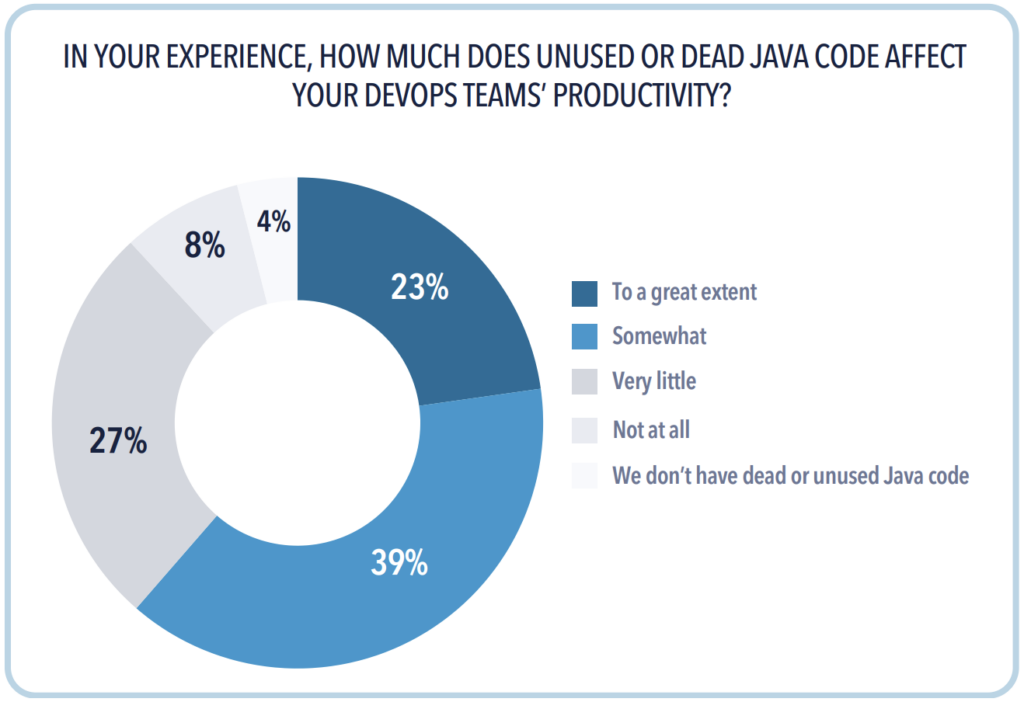
开发者的27%时间用于编写或改进代码,其余时间被虚假警报、死代码和会议占用。Azul Intelligence Cloud通过识别死代码和检测Java漏洞,帮助开发者减少无效工作,提升生产力。 2025-10-16 13:0:0 Author: securityboulevard.com(查看原文) 阅读量:11 收藏
Summary
Between the constant pinging of alerts, the rabbit holes filled with false positives, and the directories cluttered with unused and dead code, organizations are desperate to get their developers back to work. Fortunately, there is a solution that can help to do exactly that.
In this post you will learn:
- Developers spend only 27% of their time on developing or improving code
- Dead and unused code is interfering with developer productivity
- Developers need a tool to help ease the burden of wasted work
Developers, engineers, and programmers are fighting for time. Between the constant pinging of alerts, the rabbit holes filled with false positives, and the directories cluttered with unused and dead code, they are desperate to get back to work.
In Azul’s State of Java 2025 Survey & Report, 33% of participants say more than half their DevOps teams’ time is wasted addressing false positives from Java-related CVEs (Common Vulnerabilities and Exposures).

Dead or unused code is a major challenge, with 62% of survey participants reporting it hampers their DevOps teams’ effectiveness [Figure 17]. By leveraging technologies and processes to improve DevOps productivity, organizations can focus on driving innovation, growth, system resilience, customer experience, and ultimately company growth.

How do developers really spend their time?
To dig deeper, we worked with Censuswide, an international market research consultancy headquartered in London, to see where developers are actually spending their time. In other words, how much are developers developing?
Censuswide asked 200 developes, “Given your role in developing or managing applications, how much time do you spend doing the following, if any at all?”
To be sure we were targeting the right people, the short survey was fielded to only a few roles:
- Application developers (75)
- Developers (62)
- DevOps engineers (25)
- Programmers (38)
As it turns out, participants are spending only 27% of their time on writing new code or improving existing code [Figure 3]. Interestingly, directors and middle managers spend the most time in meetings and the least time getting their hands dirty with code.

How can developers get back to work?
Azul Intelligence Cloud provides actionable intelligence from Java runtime data in production. It works with any JVM from any vendor or distribution so developers stop wasting time on unproductive tasks, substantially improving productivity.
Azul enables organizations to restore developer productivity through two critical areas, identifying unused and dead code and finding known Java vulnerabilities.:
Identifying unused and dead code
The Code Inventory feature of Intelligence Cloud precisely catalogs what code runs in production across all Java workloads. It eases the burden of maintaining and testing code that never runs, significantly improving developer productivity and ultimately saving money.
Code Inventory is the only tool that collects and aggregates detailed information from the Java Virtual Machine (JVM) of what code actually runs in production over time. helps reduce clutter so teams can work only on active code, lowering maintenance effort and increasing development velocity.
Finding known Java vulnerabilities
The Vulnerability Detection feature detects vulnerable code that is used versus simply present, eliminating false positives and the associated hours of vulnerability triage. It fills a critical gap at the endpoint of the software supply chain and augments legacy tools for more accurate results.
Traditional scanning tools typically have visibility only at the JAR level in CI/CD and test environments, or they get run against a production snapshot. By comparison, Azul Vulnerability Detection, a feature of Azul Intelligence Cloud, operates at the class level in production, identifying and prioritizing known security vulnerabilities in Java applications with 100-1,000 times greater accuracy.
Learn more about Azul Intelligence Cloud.

The post Get Your Developers Back to Work appeared first on Azul | Better Java Performance, Superior Java Support.
*** This is a Security Bloggers Network syndicated blog from Security Blog Posts - Azul authored by Azul. Read the original post at: https://www.azul.com/blog/get-your-developers-back-to-work/
如有侵权请联系:admin#unsafe.sh
